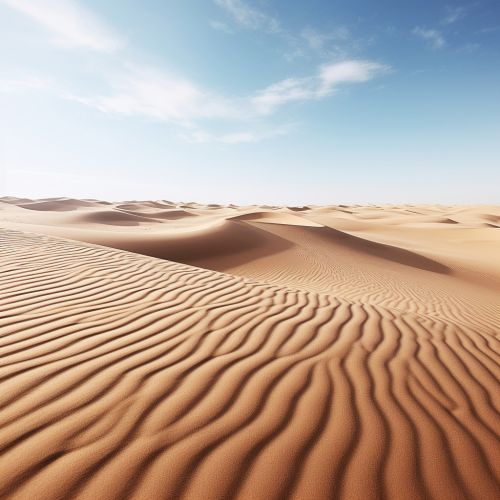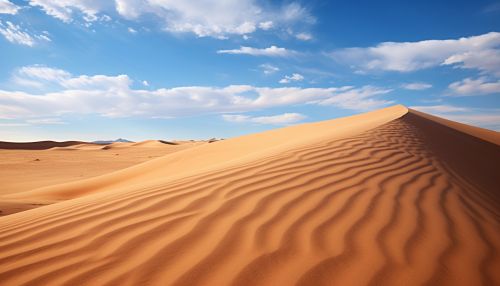Sand dunes
Formation
Sand dunes are formed by the process of aeolian or wind activity. The wind picks up and transports loose particles of sand from one area to another, often in a desert environment. This movement of sand is facilitated by the wind's ability to carry small particles over long distances. When the wind loses energy, it drops the sand particles, leading to the formation of a sand dune.
The shape and size of a sand dune depend on the characteristics of the wind and the sand. For instance, strong winds can carry larger particles and form larger dunes, while fine sand tends to form smaller, more delicate dunes. The direction of the wind also plays a crucial role in shaping the dune. A constant wind direction will result in a transverse dune, while changing wind directions will form a star dune.


Types of Sand Dunes
There are several types of sand dunes, each with its unique characteristics and formation processes. The primary types include barchan, transverse, star, parabolic, and longitudinal dunes.
Barchan Dunes
Barchan dunes are crescent-shaped dunes that form in areas with limited sand supply and a constant wind direction. The horns or arms of the dune point in the downwind direction. Barchan dunes are common in desert regions such as the Sahara.
Transverse Dunes
Transverse dunes run perpendicular to the prevailing wind direction and are typically longer than barchan dunes. They form in areas with a large supply of sand and a constant wind direction.
Star Dunes
Star dunes are pyramid-shaped dunes that form in areas with variable wind directions. They have multiple arms radiating from a central point, resembling a star.
Parabolic Dunes
Parabolic dunes, also known as U-shaped or blowout dunes, are formed by strong winds in areas with vegetation. The vegetation holds the sand in place, allowing the dune to maintain its shape.
Longitudinal Dunes
Longitudinal dunes, also known as seif dunes, are long, narrow dunes aligned parallel to the prevailing wind direction. They form in areas with a moderate sand supply.
Ecology of Sand Dunes
Despite the harsh conditions, sand dunes support a variety of plant and animal life. The organisms that inhabit sand dunes have adapted to survive in an environment with high temperatures, low water availability, and shifting sands.
Plants such as the Marram grass have deep root systems to reach water below the surface and to anchor the plant in the shifting sand. Animals, like the Dune cricket, have adapted to burrow in the sand to avoid the heat of the day.
The ecology of sand dunes also includes a succession process, where the community of organisms changes over time. This process begins with the colonization of the dune by pioneer species and ends with a stable, mature community of plants and animals.
Human Interaction with Sand Dunes
Human activities can significantly impact sand dunes. Construction, tourism, and recreational activities can cause physical damage to dunes and disrupt the delicate ecological balance.
Conversely, sand dunes also affect human activities. For instance, they can act as natural barriers, protecting inland areas from coastal storms and sea-level rise. In some cultures, sand dunes have spiritual or cultural significance.
Efforts to conserve and manage sand dunes focus on minimizing human impact, restoring damaged dunes, and maintaining the ecological balance. These efforts often involve the local community and require a deep understanding of the complex dune ecosystem.
